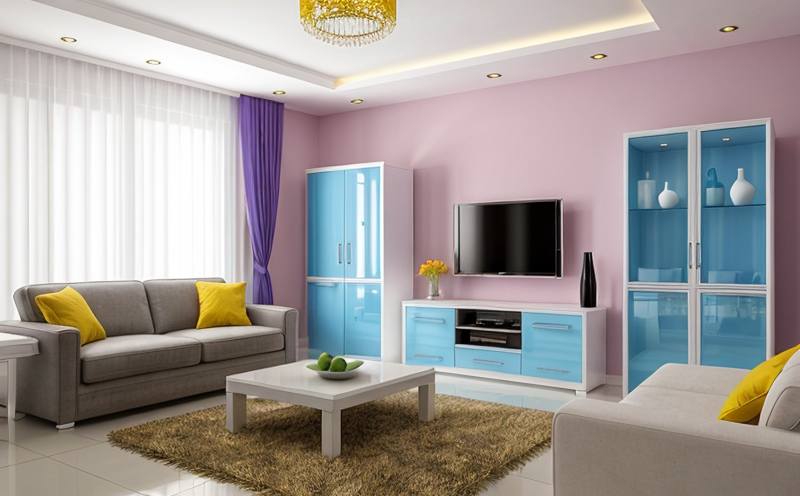DIN EN 15187 Colour Stability Testing of Decorative Plastic Coatings
The DIN EN 15187 standard specifies the methods for determining the resistance of decorative plastic coatings to changes in color under exposure to artificial light. This testing is critical for ensuring that home decoration plastics maintain their aesthetic appeal over time, which is essential for quality assurance and consumer satisfaction.
Decorative plastic coatings are widely used across various sectors including interior design, furniture manufacturing, and the automotive industry. The standard aims at providing a consistent method to evaluate how these coatings withstand exposure to light, thereby predicting their long-term durability. This ensures that products meet the expected quality standards in terms of appearance.
The testing procedure involves exposing samples to specific wavelengths of artificial light for extended periods under controlled conditions. Specimens are evaluated before and after exposure using standardized color measurement techniques to quantify any changes observed. The standard specifies detailed guidelines on sample preparation, test setup, lighting conditions, duration, and evaluation methods.
Understanding the parameters involved in this testing is crucial for accurate results. Sample preparation requires cutting specimens into rectangular shapes of standard dimensions with a thickness consistent across all samples. This ensures uniformity which is vital for reliable color measurement outcomes.
The test setup typically includes exposure chambers designed to simulate natural sunlight and artificial light sources used during the evaluation process. Specimens are placed inside these chambers at specific angles, ensuring they receive the appropriate amount of light necessary for accurate testing according to DIN EN 15187 requirements.
Lighting conditions play a significant role in this test as they directly impact the results. The standard defines precise wavelengths and durations that simulate real-world exposure scenarios. By adhering strictly to these specifications, laboratories can ensure consistent and repeatable test outcomes.
| Wavelength Range | Exposure Duration | Light Source |
|---|---|---|
| UV-A (350–400 nm) | 168 hours | Sunlight simulator |
| Visible Light (400–700 nm) | 2000 hours | Artificial daylight lamp |
Once the exposure period ends, specimens are removed from the chambers and evaluated using spectrophotometric instruments capable of measuring color changes accurately. These instruments provide quantitative data on any shift in hue or brightness that occurred during testing.
The final step involves comparing pre-test and post-test measurements to determine if significant differences exist within specified limits set forth by DIN EN 15187. If the change exceeds allowable thresholds, it indicates insufficient color stability, necessitating further investigation into formulation adjustments or process improvements.
Compliance with this standard not only enhances product quality but also contributes positively towards meeting environmental sustainability goals by promoting longer-lasting materials that require less frequent replacement, thus reducing waste generation.
Why It Matters
The importance of DIN EN 15187 cannot be overstated when considering the longevity and aesthetic appeal of home decoration plastics. Ensuring color stability through rigorous testing helps manufacturers produce high-quality products that remain visually appealing even after prolonged exposure to environmental factors such as sunlight.
Consumers expect their furnishings and decor items to look fresh for years without showing signs of wear or discoloration. By adhering to this standard, companies can build trust with customers by delivering reliable products that meet international quality benchmarks.
From an operational perspective, implementing DIN EN 15187 ensures consistency across different production batches and locations. This standardization reduces variability in performance metrics among various sites, leading to more efficient supply chains and enhanced customer satisfaction levels.
In today’s competitive market environment where sustainability practices are gaining momentum, compliance with internationally recognized standards like DIN EN 15187 can serve as a valuable differentiator for businesses looking to stand out. It demonstrates commitment not only to product quality but also environmental stewardship, thereby enhancing brand reputation and fostering customer loyalty.
Industry Applications
- Furniture manufacturing
- Interior design
- Automotive interior components
- Housing construction materials
The DIN EN 15187 standard finds wide applicability in the home decoration plastics sector. It is particularly relevant for manufacturers of furniture, where maintaining color consistency over time is crucial for customer satisfaction and brand reputation.
In interior design applications, this testing ensures that decorative elements such as wall panels or floor coverings retain their original appearance despite continuous exposure to environmental conditions like sunlight. For automotive interiors, ensuring color stability helps maintain the aesthetic appeal of vehicles even after extended use.
For housing construction materials, maintaining color integrity is essential for longevity and durability, contributing to overall building aesthetics while enhancing energy efficiency through appropriate insulation properties associated with certain colored coatings.
International Acceptance and Recognition
DIN EN 15187 is widely recognized across Europe due to its alignment with international standards such as ISO, ASTM, and EN. Its acceptance extends beyond regional borders making it a preferred choice for global manufacturers aiming to ensure consistent product quality regardless of location.
The standard's rigorous approach to evaluating color stability under artificial light sources has earned it respect among industry professionals worldwide. Compliance with this standard provides assurance that decorative plastic coatings will perform reliably across diverse climates and environments, contributing significantly towards meeting international quality requirements.





